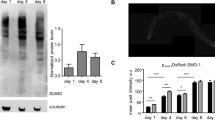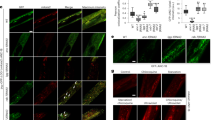Abstract
Nuclear envelope (NE) architecture and aging have been associated since the discovery that certain human progeria diseases are due to perturbations in processing of lamin A protein, generating alterations in NE morphology. However, whether changes in the NE are a causal effect of normal and premature aging is still controversial. Caenorhabditis elegans is a model organism where observations supporting both, dependent and independent roles of nuclear architecture in the aging process, have been reported. We found that the long-lived glp-1 mutant and dietary restriction delayed age-associated nuclear morphology changes. In addition, we observed that the long-lived mutant of the insulin/IGF receptor daf-2 delayed the age-dependent changes of nuclear architecture at 25 °C, as previously described. However, when daf-2 animals were incubated at 20 °C they remained long-lived, but nuclear appearance changed at similar rate as in the wild type. This supports the idea that both phenotypes, longevity and maintenance of nuclear architecture are tightly associated but can be separated and argues that nuclear morphology deterioration is not a cause of the natural aging process.





Similar content being viewed by others
References
Ahearn IM, Haigis K, Bar-Sagi D, Philips MR (2012) Regulating the regulator: post-translational modification of RAS. Nat Rev Mol Cell Biol 13(1):39–51. doi:10.1038/nrm3255
Arantes-Oliveira N, Apfeld J, Dillin A, Kenyon C (2002) Regulation of life-span by germ-line stem cells in Caenorhabditis elegans. Science 295(5554):502–505. doi:10.1126/science.1065768
Bar DZ, Gruenbaum Y (2010) Reversal of age-dependent nuclear morphology by inhibition of prenylation does not affect lifespan in Caenorhabditis elegans. Nucleus 1(6):499–505. doi:10.4161/nucl.1.6.13223
Bar DZ, Neufeld E, Feinstein N, Gruenbaum Y (2009) Gliotoxin reverses age-dependent nuclear morphology phenotypes, ameliorates motility, but fails to affect lifespan of adult Caenorhabditis elegans. Cell Motil Cytoskelet 66(10):791–797. doi:10.1002/cm.20347
Chen D, Thomas EL, Kapahi P (2009) HIF-1 modulates dietary restriction-mediated lifespan extension via IRE-1 in Caenorhabditis elegans. PLoS Genet 5(5):e1000486. doi:10.1371/journal.pgen.1000486
Eriksson M, Brown WT, Gordon LB, Glynn MW, Singer J, Scott L, Erdos MR, Robbins CM, Moses TY, Berglund P, Dutra A, Pak E, Durkin S, Csoka AB, Boehnke M, Glover TW, Collins FS (2003) Recurrent de novo point mutations in lamin A cause Hutchinson–Gilford progeria syndrome. Nature 423(6937):293–298. doi:10.1038/nature01629
Gems D, Sutton AJ, Sundermeyer ML, Albert PS, King KV, Edgley ML, Larsen PL, Riddle DL (1998) Two pleiotropic classes of daf-2 mutation affect larval arrest, adult behavior, reproduction and longevity in Caenorhabditis elegans. Genetics 150(1):129–155
Gordon LB, Kleinman ME, Miller DT, Neuberg DS, Giobbie-Hurder A, Gerhard-Herman M, Smoot LB, Gordon CM, Cleveland R, Snyder BD, Fligor B, Bishop WR, Statkevich P, Regen A, Sonis A, Riley S, Ploski C, Correia A, Quinn N, Ullrich NJ, Nazarian A, Liang MG, Huh SY, Schwartzman A, Kieran MW (2012) Clinical trial of a farnesyltransferase inhibitor in children with Hutchinson–Gilford progeria syndrome. Proc Natl Acad Sci USA 109(41):16666–16671. doi:10.1073/pnas.1202529109
Haithcock E, Dayani Y, Neufeld E, Zahand AJ, Feinstein N, Mattout A, Gruenbaum Y, Liu J (2005) Age-related changes of nuclear architecture in Caenorhabditis elegans. Proc Natl Acad Sci USA 102(46):16690–16695
Kenyon CJ (2010) The genetics of ageing. Nature 464(7288):504–512. doi:10.1038/nature08980
Lin K, Dorman JB, Rodan A, Kenyon C (1997) daf-16: an HNF-3/forkhead family member that can function to double the life-span of Caenorhabditis elegans. Science 278(5341):1319–1322
Ogg S, Paradis S, Gottlieb S, Patterson GI, Lee L, Tissenbaum HA, Ruvkun G (1997) The Fork head transcription factor DAF-16 transduces insulin-like metabolic and longevity signals in C. elegans. Nature 389(6654):994–999. doi:10.1038/40194
Paradis S, Ailion M, Toker A, Thomas JH, Ruvkun G (1999) A PDK1 homolog is necessary and sufficient to transduce AGE-1 PI3 kinase signals that regulate diapause in Caenorhabditis elegans. Genes Dev 13(11):1438–1452
Puente XS, Quesada V, Osorio FG, Cabanillas R, Cadinanos J, Fraile JM, Ordonez GR, Puente DA, Gutierrez-Fernandez A, Fanjul-Fernandez M, Levy N, Freije JM, Lopez-Otin C (2011) Exome sequencing and functional analysis identifies BANF1 mutation as the cause of a hereditary progeroid syndrome. Am J Hum Genet 88(5):650–656. doi:10.1016/j.ajhg.2011.04.010
Raz V, Vermolen BJ, Garini Y, Onderwater JJ, Mommaas-Kienhuis MA, Koster AJ, Young IT, Tanke H, Dirks RW (2008) The nuclear lamina promotes telomere aggregation and centromere peripheral localization during senescence of human mesenchymal stem cells. J Cell Sci 121(Pt 24):4018–4028. doi:10.1242/jcs.034876
Reddy S, Comai L (2012) Lamin A, farnesylation and aging. Exp Cell Res 318(1):1–7. doi:10.1016/j.yexcr.2011.08.009
Righolt CH, van ‘t Hoff ML, Vermolen BJ, Young IT, Raz V (2011) Robust nuclear lamina-based cell classification of aging and senescent cells. Aging (Albany NY) 3(12):1192–1201
Scaffidi P, Misteli T (2006) Lamin A-dependent nuclear defects in human aging. Science 312(5776):1059–1063. doi:10.1126/science.1127168
Stiernagle T (2006) Maintenance of C. elegans. WormBook:1–11. doi:10.1895/wormbook.1.101.1
Varela I, Cadinanos J, Pendas AM, Gutierrez-Fernandez A, Folgueras AR, Sanchez LM, Zhou Z, Rodriguez FJ, Stewart CL, Vega JA, Tryggvason K, Freije JM, Lopez-Otin C (2005) Accelerated ageing in mice deficient in Zmpste24 protease is linked to p53 signalling activation. Nature 437(7058):564–568. doi:10.1038/nature04019
Wolkow CA, Munoz MJ, Riddle DL, Ruvkun G (2002) Insulin receptor substrate and p55 orthologous adaptor proteins function in the Caenorhabditis elegans daf-2/insulin-like signaling pathway. J Biol Chem 277(51):49591–49597. doi:10.1074/jbc.M207866200
Worman HJ (2012) Nuclear lamins and laminopathies. J Pathol 226(2):316–325. doi:10.1002/path.2999
Yang SH, Bergo MO, Toth JI, Qiao X, Hu Y, Sandoval S, Meta M, Bendale P, Gelb MH, Young SG, Fong LG (2005) Blocking protein farnesyltransferase improves nuclear blebbing in mouse fibroblasts with a targeted Hutchinson–Gilford progeria syndrome mutation. Proc Natl Acad Sci USA 102(29):10291–10296. doi:10.1073/pnas.0504641102
Acknowledgements
We wish to thank Y. Gruenbaum for the PD4810 strain and J. Rueda-Carrasco for technical assistance as well as M. Artal-Sanz, A.M. Brokate-Llanos and A. Miranda-Vizuete for discussion on the manuscript. This work was funded by the Autonomous Government of Andalusia (P07-CVI-02697). In addition, we wish to acknowledge Fundación Ramón Areces for a fellowship to ER. Some nematode strains used in this work were provided by the “Caenorhabditis Genetic Center”, which is funded by the NIH National Center for Research Resources (NCRR).
Author information
Authors and Affiliations
Corresponding authors
Electronic supplementary material
Below is the link to the electronic supplementary material.
Rights and permissions
About this article
Cite this article
Pérez-Jiménez, M.M., Rodríguez-Palero, M.J., Ródenas, E. et al. Age-dependent changes of nuclear morphology are uncoupled from longevity in Caenorhabditis elegans IGF/insulin receptor daf-2 mutants. Biogerontology 15, 279–288 (2014). https://doi.org/10.1007/s10522-014-9497-0
Received:
Accepted:
Published:
Issue Date:
DOI: https://doi.org/10.1007/s10522-014-9497-0




